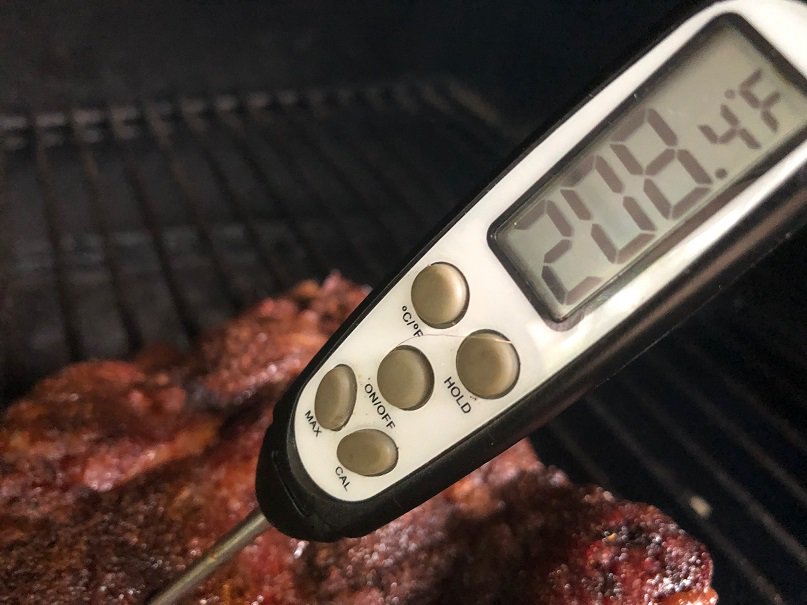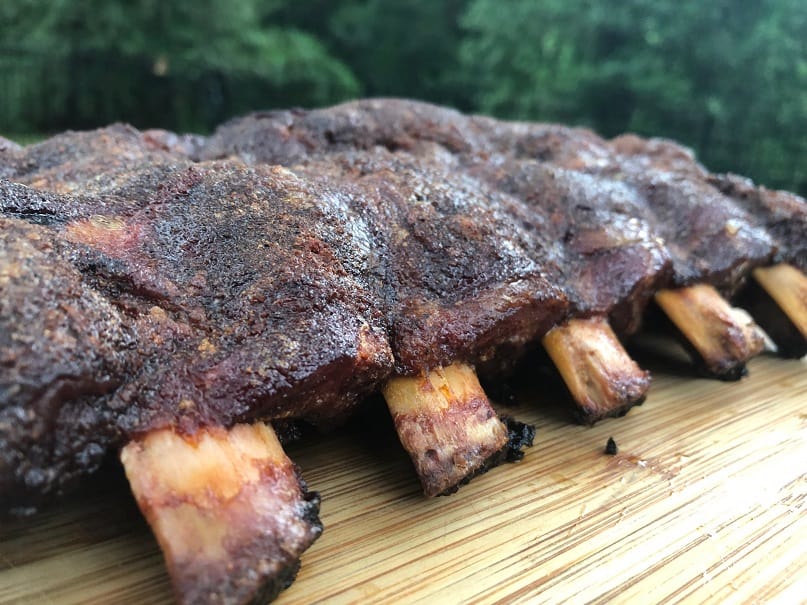Smoked Beef Rib Recipe
The general steps for smoking beef ribs are pretty simple.
- Remove the membrane from the bone side of the ribs
- Add salt and pepper to the ribs, or one of the other rubs I’ll list below.
- Let the beef sit with the ribs for an hour to allow the seasoning to begin to melt into it.
- Using hickory as the smoke wood, heat your barbecue pit to 250°F.
- Spray the ribs after the crust has set every 30 minutes.
- Smoke for 4-6 hours until probe tender.
On my pellet grill, I smoke ribs using this technique. You can use this guide if you’re using an electric smoker, but you’ll need to replace your wood chips every 30-45 minutes.
Okay, now that you’ve seen the broad steps, let’s look at some specifics.
How Long to Smoke Beef Ribs at 250F
Whether you are cooking thin Back Ribs or thick Short Ribs will greatly affect how long the ribs take to cook.
Short ribs will typically take 6 hours to smoke at 250°F, compared to 4 hours for back ribs.
By the way, if all your grocery store has to offer are depressing slabs of back ribs with scant amounts of meat, and you’d rather get your hands on some gorgeous, thick, and meaty short ribs, then this is a great guide to some online sources.
For ribs smoked at 250F on my pellet grill, these are my cook times.
To give beef ribs a little bit more time in the smoke, some people like to cook them at 225°F. If you choose that option, you should anticipate that the cooking time will increase by about an hour. For a better bark, some people prefer to cook beef ribs at 275-300F. If you do, you should anticipate that the cooking time will be about an hour shorter.
Of course, things like how frequently you open the lid of your pit, the grade of the beef, etc. will come into play as well.
Check out this list of Ten Easy Meats You Can Smoke in Under Four Hours if you don’t have 4-6 hours and want something you can prepare faster.
Preparing the Ribs for the Smoker
The “meat side” or front of beef ribs is typically quite clean, free of fat deposits, and requires little preparation. Here is a picture of a slab of back ribs.
The “bone side” of the ribs on the back is another matter. The back of the ribs have a tough membrane that needs to be removed. I grab the edge and pull it firmly with some paper towels. The majority of the time, it requires me several tries to get it all off, though occasionally I can get it off in one big piece.
This membrane needs to be removed because eating it will feel like chewing rawhide and it will only become tougher when cooked. The membrane also keeps smoke and seasoning from getting to the back of the ribs. This membrane is present on both back and short ribs.
There may occasionally be substantial fat packets under the membrane. I remove the fat deposits even though it isn’t strictly necessary.
There are numerous options available when it comes to dry rubs for beef ribs. One of the best rubs for beef is a standard that only includes salt, pepper, onion, and garlic.
Classic SPOG Beef Rub
- 1/4 cup kosher salt
- 1/4 cup ground black pepper
- 1 tablespoon granulated garlic
- 1 tablespoon granulated onion
Another classic, Montreal Steak Seasoning, was used to prepare these flavorful beef short ribs.
These flavorful beef ribs are also known as “Brisket on a Stick.” Given this, it would make sense to use any of these brisket rubs that won competitions on your ribs. Personally, I believe that instead of brisket, beef ribs taste more like smoked chuck roast.
Before applying the rub, some people like to coat the ribs in a binder like mustard, mayonnaise, or olive oil to help the rub stick better. I haven’t discovered that using a binder is actually necessary when smoking ribs, but you are certainly welcome to do so.
Ideally you will let the rub melt into the meat for about an hour before the ribs go onto the smoker.
You can always add a few extras to these ribs to suit your taste preferences and develop your own traditional barbecue recipe.
Choice of Smoking Wood
The best woods for smoking brisket are generally considered to be oak and hickory, and they work just fine for beef ribs as well. However, you also have other choices to consider that will result in fantastic barbecue. I love smoking beef with cherry wood, and when I lived in Texas, I also loved the results of using pecan.
Using a pellet grill for smoking allows you to experiment with all of the available wood flavor blends. See some of the best ones in the article titled “Best Wood Pellets for Smoking Meat.”
Start checking to see if the rub has set after the first two hours in the smoker. When a crust forms and makes noise when you tap it with tongs, the rub has “set.”
After the rub has had time to set, begin misting the ribs every 30 minutes or so. Although many people opt for straight apple juice or even plain water, a 50:50 mixture of apple juice and black coffee adds some nice complexity. Some people contend that the spritz makes the smoke adhere to the meat more effectively and prevents the surface of the ribs from drying out.
How Do You Know When the Ribs are Done?
When the ribs are done cooking and ready to eat, there are three signs to look for.
Your finished ribs will have an internal temperature in the 205-210F range. While using internal temperature as a guide is helpful, the real test occurs when the thermometer is inserted into the meat.
If the thermometer simply slides into the meat like it is going into warm butter then you know that all of the tough parts have melted away and the ribs will be fall off the bone tender. In addition to tenderness and internal temperature, another excellent way to check for doneness is to see if the meat has pulled back from the bone. This is not a definitive test though as every slab of ribs pulls back to a different degree. Here is an example of the meat really pulling back on a slab of finished short ribs.
In addition to tenderness and internal temperature, another excellent way to check for doneness is to see if the meat has pulled back from the bone. This is not a definitive test though as every slab of ribs pulls back to a different degree. Here is an example of the meat really pulling back on a slab of finished short ribs.
Here is a picture of the much smaller pullback I received on this slab of back ribs in contrast.
 When the ribs are probe tender go ahead and pull then from the pit and let them rest a minute before slicing. The resting doesn’t really help with “letting the juices distribute through the meat” but it sure helps slow things down and keeps you from burning your mouth on a big pile of hot beef!
When the ribs are probe tender go ahead and pull then from the pit and let them rest a minute before slicing. The resting doesn’t really help with “letting the juices distribute through the meat” but it sure helps slow things down and keeps you from burning your mouth on a big pile of hot beef!
This is How To Smoke Beef BACK Ribs the Best Way
FAQ
How long to smoke beef back ribs at 250 degrees?
Set the smoker for 235-250 degrees Fahrenheit. I smoke beef back ribs with pecan or oak wood. To keep the ribs moist while smoking them for about three hours, you can mist them with some apple juice.
How long to smoke beef ribs at 250 per pound?
Short ribs should be placed on the smoker and smoked at 250°F for 5 to 6 hours, or until the thickest part of the meat reaches an internal temperature of about 175°F. I advise using a reliable leave-in meat thermometer so you won’t need to check the short ribs frequently.
How long do you smoke beef back ribs at 225?
Place the beef ribs in the smoker at 225°F (110°C), bone-side down (or up if your heat source is coming from the top), and cook for three hours. You should have a nice bark established at this point.
How long to smoke 4lbs of beef back ribs?
Place the ribs in the smoker and cook for about 3 hours at 275°F. The middle intercostal muscle should reach a temperature of 205-210 when finished, but you can tell when it’s ready by simply running a skewer through it.
